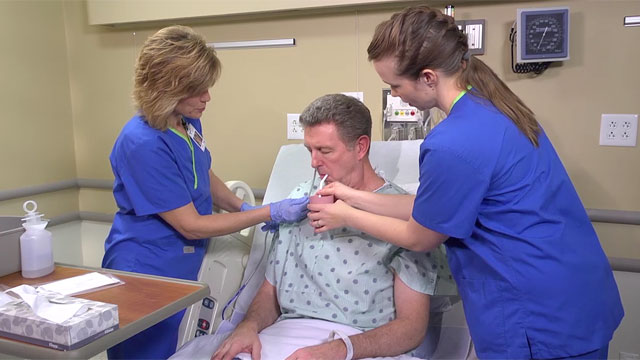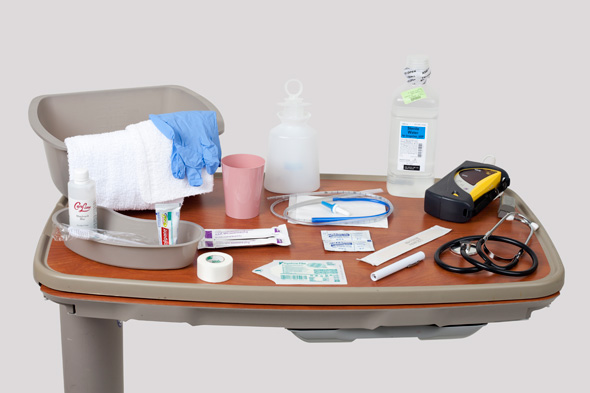Enteral Nutrition
Select a Skill:
Take the Review Test:

Safety
- Know the purpose of the feeding and the intended location of the tip of the feeding tube.
- The most serious complication of NG tube insertion is inadvertent pulmonary intubation.
- Be aware of factors that increase the risk for complications related to feeding tube insertion: altered level of consciousness, abnormal clotting, impaired gag reflex, or impaired cough reflex.
- Do not force the tube or push it against resistance. If the patient starts to cough, experiences a drop in oxygen saturation, or shows other signs of respiratory distress, withdraw the tube into the posterior nasopharynx until normal breathing resumes.
- X-ray confirmation of correct tube placement is mandatory before enteral feeding or medication administration through a blindly placed feeding tube.
- If feedings are infusing and you suspect aspiration of stomach contents into the respiratory tract, as evidenced by fever, dyspnea, or auscultation of crackles or wheezes, pause the machine or stop the infusion, report the change in the patient’s condition to the health care provider, suggest ordering a chest x-ray if there has not been one recently, and prepare to initiate antibiotics.
Equipment
(Roll cursor over items to see labels)

Nasogastric tube without stylet 8-12 Fr
Antireflux valve
60 mL catheter tip syringe
Irrigation container
500 mL sterile water
Stethoscope
Pulse oximeter
Hypoallergenic tape
Transparent dressing
Tincture of benzoin
Cup of water and straw
Clean gloves
Penlight
Tongue blade
Water-based lubricant
Oral hygiene supplies
Basin
Washcloth/towel
Delegation
The skill of feeding tube insertion may not be delegated to nursing assistive personnel (NAP). However, NAP may assist with patient positioning and comfort measures during tube insertion.
Preparation
- Verify the health care provider’s orders for the type of tube and the enteric feeding schedule.
- Review the patient’s medical history for basilar skull fracture, nasal problems, nosebleeds, facial trauma, nasal-facial surgery, deviated septum, anticoagulant therapy, and coagulopathy.
- Assess the patient’s knowledge of the procedure.
- Have the patient close each nostril alternately and breathe. Examine each naris for patency and skin breakdown.
- Assess the patient’s mental status, ability to cooperate with the procedure, sedation, presence of cough reflex and gag reflex, ability to swallow, critical illness, and presence of an artificial airway.
- Perform a physical assessment of the abdomen.
- Explain the procedure to the patient, including any sensations the patient will feel during tube insertion.
- Tell the patient to communicate gagging or discomfort during intubation by raising an index finger.
Follow-up
- Observe the patient to determine his or her response to intubation. Have the patient speak.
- Check the patient’s vital signs and oxygen saturation.
- Confirm the x-ray results.
- Remove the stylet, if used, after x-ray verification of the correct placement of the tube.
- Routinely assess the location of the external exit site marking on the tube.
- Routinely assess the color and pH of fluid withdrawn from the tube.
Documentation
Record and report the following:
- The type and size of tube placed
- Location of the distal tip of the tube
- The patient’s tolerance of the procedure
- Confirmation of the tube’s position by x-ray examination
- Any unexpected outcome and the interventions performed
Review Questions
1. What would the nurse do if he or she were not able to insert a nasogastric tube in either of a patient’s nares?
 Ask another nurse to attempt the insertion.
Ask another nurse to attempt the insertion. Document the attempts in the patient’s medical record.
Document the attempts in the patient’s medical record. Notify the physician that the attempts were unsuccessful.
Notify the physician that the attempts were unsuccessful. Allow the patient to rest for 30 minutes before resuming the process.
Allow the patient to rest for 30 minutes before resuming the process.
2. What would the nurse do if he or she encountered resistance when inserting a nasogastric tube?
 Ask the patient to cough.
Ask the patient to cough. Withdraw the tube to the nasopharynx.
Withdraw the tube to the nasopharynx. Encourage the patient to swallow.
Encourage the patient to swallow. Instruct the patient to hyperextend the neck.
Instruct the patient to hyperextend the neck.
3. Which patient does not have a medical condition that contraindicates placement of a nasogastric tube?
 A 28-year-old patient who fractured a femur after heavy drinking
A 28-year-old patient who fractured a femur after heavy drinking A 73-year-old patient who is on anticoagulation therapy.
A 73-year-old patient who is on anticoagulation therapy.  A 54-year-old patient who broke a cheekbone in a fall
A 54-year-old patient who broke a cheekbone in a fall A 67-year-old patient with a history of unexplained nosebleeds
A 67-year-old patient with a history of unexplained nosebleeds
4. What might the nurse do to reduce the patient’s discomfort before inserting a nasogastric tube?
 Examine each naris for patency and skin breakdown.
Examine each naris for patency and skin breakdown. Place the patient in the high-Fowler’s position.
Place the patient in the high-Fowler’s position. Anesthetize the throat.
Anesthetize the throat. Have the patient take a few sips of water.
Have the patient take a few sips of water.
5. Which intervention might the nurse delegate to nursing assistive personnel (NAP) when inserting a nasogastric tube?
 Positioning the patient in a high-Fowler’s position
Positioning the patient in a high-Fowler’s position Assessing the patient’s abdomen for bowel sounds
Assessing the patient’s abdomen for bowel sounds Determining any history of unexplained nosebleeds
Determining any history of unexplained nosebleeds Educating the patient about the need for the intervention
Educating the patient about the need for the intervention
You have completed the Review Questions for this skill. To take the Review again select the Start Over button. To proceed to another skill select from the dropdown menu. Select the Home or Back button to proceed to the next section.

